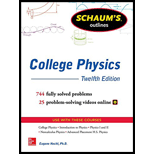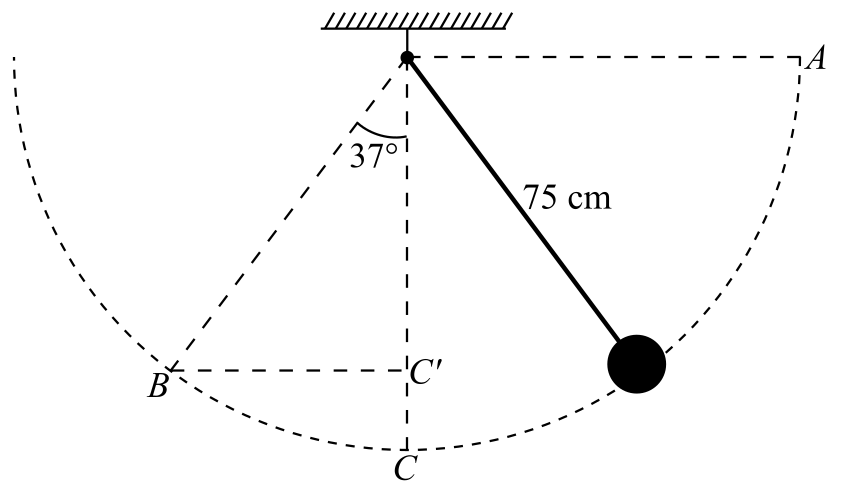
Concept explainers
Consider the simple pendulum shown in Fig. 6-7. (a) If it is released from point-A, what will be the speed of the ball as it passes through point-C? (b) What is the ball’s speed at point-B? [Hint: How far has it fallen upon arriving at point-B?]
![Chapter 6, Problem 45SP, 6.45 [II] Consider the simple pendulum shown in Fig. 6-7. (a) If it is released from point-A, what](https://content.bartleby.com/tbms-images/9781259587399/Chapter-6/images/87399-6-45sp-question-digital_image81.png)
Fig. 6-7
(a)
The speed of the ball at point C attached to a string of length
Answer to Problem 45SP
Solution:
Explanation of Solution
Given data:
Refer to Fig. 6-7.
The length of the string is
Formula used:
Understand that, for a simple pendulum at its lowest point, the kinetic energy is maximum and the potential energy is zero, while at its highest point, the potential energy is maximum and the kinetic energy is zero.
The expression for change in kinetic energy is written as:
Here,
The expression for change in potential energy is written as:
Here,
Explanation:
There is no work done on the ball. Also, the ball’s total energy remains constant, that is, it loses a part of its potential energy but gains an equal amount ofkinetic energy. Therefore,
Substitute
The velocity at the highest point is zero. Therefore,
Recall the expression for the work energy theorem.
Substitute
Conclusion:
The speed of the ball at point C is
(b)
The speed of the ball at point B attached to a string of length
Answer to Problem 45SP
Solution:
Explanation of Solution
Given data:
Refer to Fig. 6-7.
The length of the string is
Formula used:
Understand that, for a simple pendulum at its lowest point, the kinetic energy is maximum and the potential energy is zero, while at its highest point, the potential energy is maximum and the kinetic energy is zero.
The expression for change in kinetic energy is written as:
Here,
The expression for change in potential energy is written as:
Here,
Explanation:
Draw the diagram of a simple pendulum.

There is no work done on the ball. Also, the ball’s total energy remains constant, that is, it loses a part of its kinetic energy but gains an equal amount of potential energy. Therefore,
Substitute
Consider the diagram and determine the distance between points
From previous part, the velocity at point C is
Recall the expression for the work energy theorem.
Substitute
Conclusion:
The speed of ball at point B is
Want to see more full solutions like this?
Chapter 6 Solutions
Schaum's Outline of College Physics, Twelfth Edition (Schaum's Outlines)
Additional Science Textbook Solutions
Cosmic Perspective Fundamentals
Chemistry: Atoms First
Concepts of Genetics (12th Edition)
Biology: Concepts and Investigations
Loose Leaf For Integrated Principles Of Zoology
Applications and Investigations in Earth Science (9th Edition)
- please solve and answer the question correctly. Thank you!!arrow_forward18arrow_forward1. Some 1800 years ago Roman soldiers effectively used slings as deadly weapons. The length of these slings averaged about 81 cm and the lead shot that they used weighed about 30 grams. If in the wind up to a release, the shot rotated around the Roman slinger with a period of .14 seconds. Find the maximum acceleration of the shot before being released in m/s^2 and report it to two significant figures.arrow_forward
- 16arrow_forward11. A small charged plastic ball is vertically above another charged small ball in a frictionless test tube as shown in the figure. The balls are in equilibrium at a distance d= 2.0 cm apart. If the charge on one ball is tripled, find the new equilibrium distance between the balls in cm and report it to the proper number of significant figures.arrow_forward12. The electric field at a point 1.3 cm from a small object points toward the object with a strength of 180,000 N/C. Find the object's charge q, in nC to the proper number of significant figures. k = 1/4πε0 = 8.99 × 10^9 N ∙ m^2/C^2arrow_forward
- 14. When the potential difference between the plates of an ideal air-filled parallel plate capacitor is 35 V, the electric field between the plates has a strength of 670 V/m. If the plate area is 4.0 × 10^-2 m^2, what is the capacitance of this capacitor in pF? (ε0 = 8.85 × 10^-12 C^2/N ∙ m^2)arrow_forward10. A small styrofoam ball of mass 0.500 g is placed in an electric field of 1140 N/C pointing downward. What excess charge must be placed on the ball for it to remain suspended in the field? Report your answer in micro-Coulombs to three significant figures.arrow_forward2arrow_forward
 Principles of Physics: A Calculus-Based TextPhysicsISBN:9781133104261Author:Raymond A. Serway, John W. JewettPublisher:Cengage Learning
Principles of Physics: A Calculus-Based TextPhysicsISBN:9781133104261Author:Raymond A. Serway, John W. JewettPublisher:Cengage Learning University Physics Volume 1PhysicsISBN:9781938168277Author:William Moebs, Samuel J. Ling, Jeff SannyPublisher:OpenStax - Rice University
University Physics Volume 1PhysicsISBN:9781938168277Author:William Moebs, Samuel J. Ling, Jeff SannyPublisher:OpenStax - Rice University Glencoe Physics: Principles and Problems, Student...PhysicsISBN:9780078807213Author:Paul W. ZitzewitzPublisher:Glencoe/McGraw-Hill
Glencoe Physics: Principles and Problems, Student...PhysicsISBN:9780078807213Author:Paul W. ZitzewitzPublisher:Glencoe/McGraw-Hill Physics for Scientists and Engineers: Foundations...PhysicsISBN:9781133939146Author:Katz, Debora M.Publisher:Cengage Learning
Physics for Scientists and Engineers: Foundations...PhysicsISBN:9781133939146Author:Katz, Debora M.Publisher:Cengage Learning College PhysicsPhysicsISBN:9781305952300Author:Raymond A. Serway, Chris VuillePublisher:Cengage Learning
College PhysicsPhysicsISBN:9781305952300Author:Raymond A. Serway, Chris VuillePublisher:Cengage Learning Physics for Scientists and Engineers with Modern ...PhysicsISBN:9781337553292Author:Raymond A. Serway, John W. JewettPublisher:Cengage Learning
Physics for Scientists and Engineers with Modern ...PhysicsISBN:9781337553292Author:Raymond A. Serway, John W. JewettPublisher:Cengage Learning





